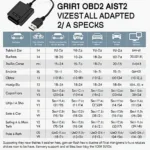OBD2, or On-Board Diagnostics II, is a standardized system that allows you to communicate with your vehicle’s computer. This obd2 tutorial will guide you through everything you need to know, from understanding the basics to using your OBD2 scanner effectively. We’ll cover various topics, from simple code reading to more advanced diagnostics.
If you’re looking to delve into the world of OBD2, you’re in the right place. This comprehensive guide will equip you with the knowledge and skills you need to understand and use your OBD2 scanner like a pro. Whether you’re a seasoned mechanic or a curious car owner, this tutorial has something for everyone. Learn more about OBD2 software in Spanish at obd2 software español.
What is OBD2 and Why Should You Care?
OBD2 is essentially the language your car uses to tell you what’s going on under the hood. It’s a valuable tool for anyone who owns a car, enabling you to diagnose problems, monitor performance, and even save money on repairs. Imagine being able to understand why your check engine light is on before heading to a mechanic. That’s the power of OBD2.
Getting Started with Your OBD2 Scanner
Choosing the right scanner is the first step. There are various types available, from basic code readers to professional-grade scan tools. Consider your needs and budget when making your selection. Once you have your scanner, locating the OBD2 port is usually straightforward. It’s typically located under the dashboard on the driver’s side.
Understanding OBD2 Codes
OBD2 codes are standardized, meaning a specific code indicates the same problem across different vehicle makes and models. These codes are usually formatted as a letter followed by four numbers. For example, P0300 indicates a random misfire. While knowing the codes is important, understanding what they mean is crucial. A reliable resource like OBDFree can help you decipher these codes accurately. You can also find valuable resources on platforms like obd2 youtube.
How to Read OBD2 Codes
Connect your scanner to the OBD2 port and turn on the ignition. Follow the instructions specific to your scanner model to initiate the scan. The scanner will then retrieve any stored trouble codes. Record these codes before clearing them.
Beyond Basic Code Reading: Advanced OBD2 Functions
Many OBD2 scanners offer more than just code reading. Some allow you to view live data streams, monitor sensor readings, and even perform specific tests. These advanced features can provide valuable insights into your vehicle’s performance and help pinpoint issues more accurately. For more advanced tuning options, check out toad pro obd2 auto tuning software.
Utilizing Live Data for Diagnostics
Live data can help you understand how different systems are functioning in real-time. This can be particularly useful for diagnosing intermittent problems or tracking down performance issues.
“Understanding live data is like having a window into your car’s soul,” says Michael Davis, a seasoned automotive technician. “It allows you to see what’s happening beneath the surface and catch problems before they become major headaches.”
Troubleshooting Common OBD2 Issues
Sometimes, you might encounter issues while using your OBD2 scanner. These could range from connection problems to difficulty interpreting codes. Don’t worry, most issues are easily resolved. For tablet-based OBD2 solutions, explore the topdon tablet obd2 scanner artipad.
What if My Scanner Isn’t Connecting?
Double-check the connection to the OBD2 port and ensure the ignition is on. If the problem persists, consult your scanner’s manual or seek assistance online. For helpful video tutorials, you can check bluedriver obd2 youtube.
“A common mistake is forgetting to turn the ignition on,” adds Sarah Johnson, an automotive diagnostics expert. “Always make sure the car is ready to communicate with the scanner.”
Conclusion
This obd2 tutorial has provided a comprehensive overview of OBD2, from the basics to more advanced concepts. By understanding and utilizing your OBD2 scanner, you can empower yourself to take control of your vehicle’s maintenance and diagnostics.
FAQ
- What does OBD2 stand for? On-Board Diagnostics II.
- Where is the OBD2 port located? Usually under the dashboard on the driver’s side.
- What do OBD2 codes mean? They indicate specific problems within the vehicle’s systems.
- How do I read OBD2 codes? Connect your scanner, turn on the ignition, and follow the scanner’s instructions.
- What are advanced OBD2 functions? Live data streaming, sensor monitoring, and specific tests.
- What if my scanner isn’t connecting? Check the connection and ignition, consult the manual, or seek online assistance.
- Where can I find more information about OBD2? Websites like OBDFree offer comprehensive resources.
Need help with your car diagnostics? Contact our 24/7 support team via WhatsApp: +1(641)206-8880 or Email: cardiagtechworkshop@gmail.com.


